市場新聞與洞察
透過專家洞察、新聞與技術分析,助你領先市場,制定交易決策。
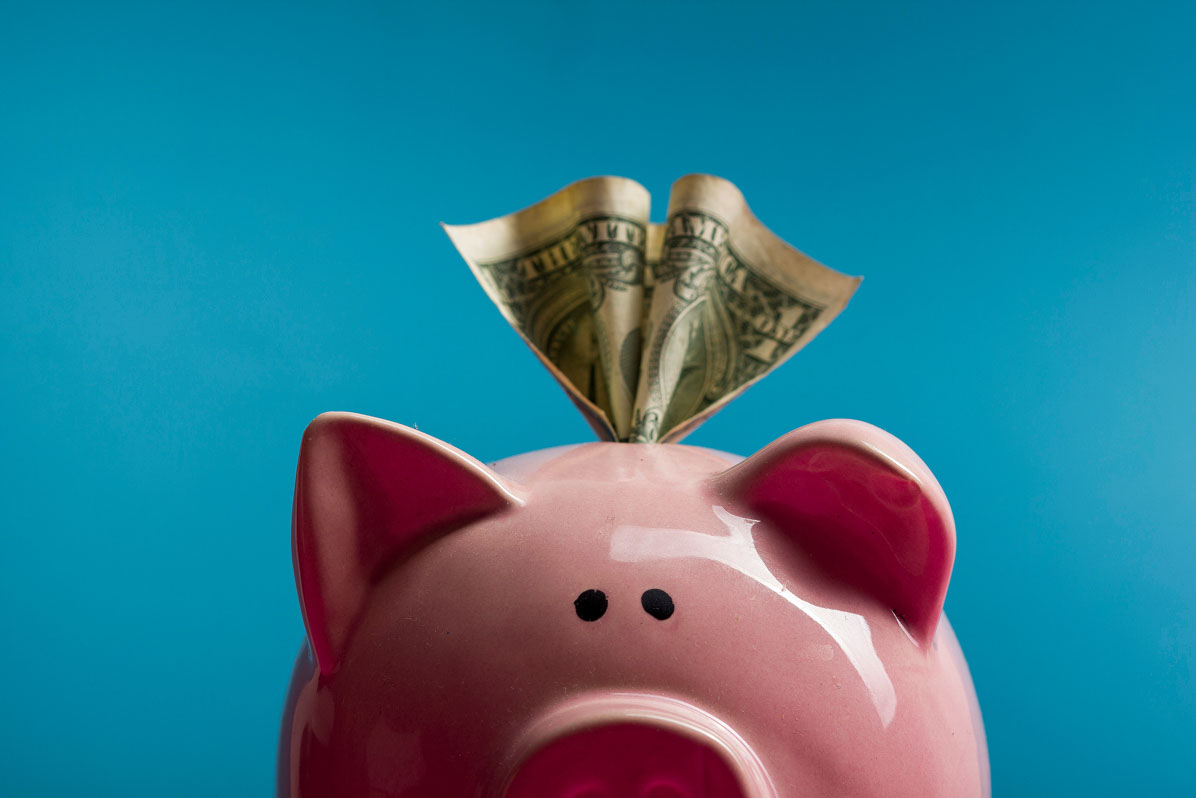
S&P 500 and ASX Rally as Big Banks Drive Markets
Both the S&P 500 and ASX have rallied on the back of stronger-than-expected major bank earnings reports on both sides of the Pacific.
In the US, Bank of America reported a 31% year-over-year increase in earnings per share at $1.06, exceeding Wall Street's estimate of $0.95. Meanwhile, Morgan Stanley delivered a record-breaking quarter with EPS of $2.80, a nearly 49% increase from the same period last year.
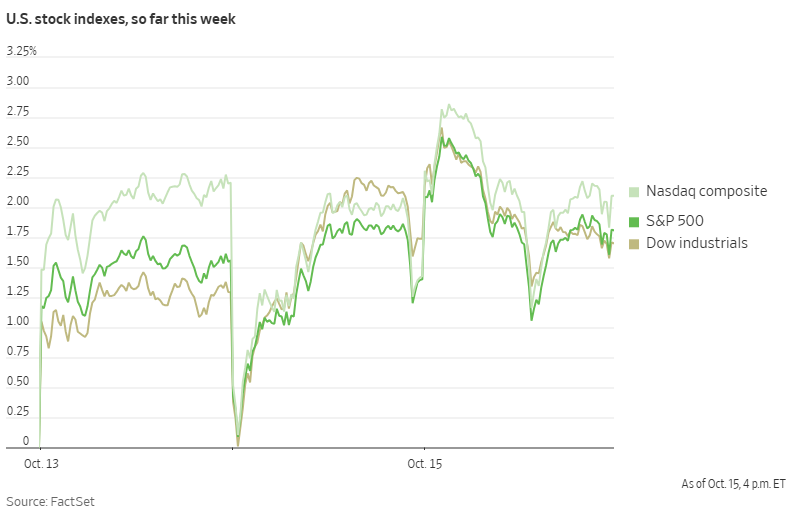
On the Australian front, the benchmark ASX 200 leapt 1.03% to 8990.99, with all four major Australian banks playing a major role. CBA closed 1.45% higher, Westpac 1.98%, NAB 1.87%, and ANZ 0.53%.
These strong bank results indicate broader economic strength, despite recent concerns about US-China trade tensions. US Treasury Secretary Scott Bessent emphasised that Washington did not want to escalate trade conflict with China and noted that President Trump is ready to meet Chinese President Xi Jinping in South Korea later this month.
With the third-quarter earnings season just getting underway, these early positive results from financial institutions could prove as the start of continued market strength through to the end of the year.
U.S. Government Shutdown Likely to Last Into November
Washington remains gridlocked as the U.S. enters its 16th day of shutdown. With no signs of compromise on the horizon, it appears increasingly likely the shutdown will extend into November and could even compromise the Thanksgiving holiday season.
Treasury Secretary Scott Bessent has warned "we are starting to cut into muscle here" and estimated "the shutdown may start costing the US economy up to $15 billion a day."
The core issue driving the shutdown is healthcare policy, specifically the expiring Affordable Care Act subsidies. Democrats are demanding these subsidies be extended, while Republicans argue this issue can be addressed separately from government funding.
The Trump administration has taken steps to blunt some of the shutdown's immediate impact, including reallocating funds to pay active-duty soldiers this week and infusing $300 million into food aid programs.
However, House Speaker Mike Johnson has emphasised these are merely "temporary fixes" that likely cannot be repeated at the end of October when the next round of military paychecks is scheduled.
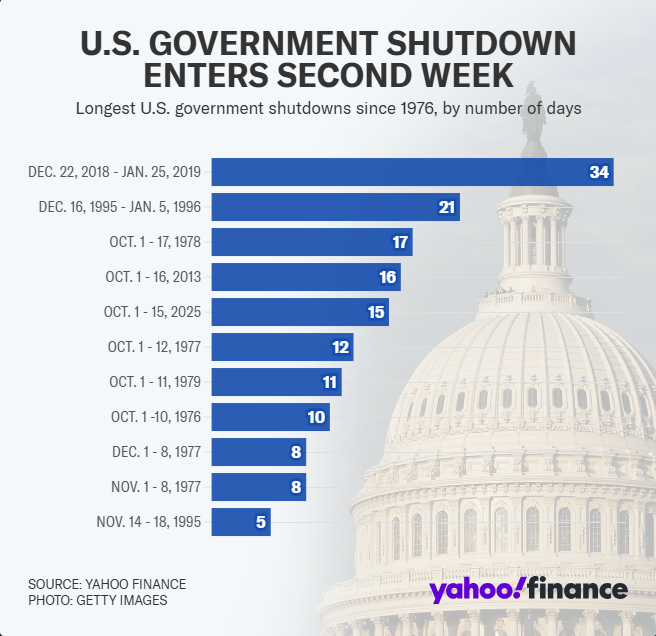
By the end of this week, this shutdown will become the third-longest in U.S. history. If it continues into November 4th, it will surpass the 34-day shutdown of 2018-2019 to become the longest government shutdown ever recorded.
This prolonged shutdown adds another layer of volatility to markets. While previous shutdowns have typically had limited long-term market impacts, the unprecedented length and timing of this closure, combined with its expanding economic toll, warrant closer attention as we move toward November.
Trump Announces Modi Has Agreed to Stop Buying Russian Oil
Yesterday, Trump announced that Indian Prime Minister Narendra Modi has agreed to stop purchasing Russian oil. He stated that Modi assured him India would halt Russian oil imports "within a short period of time," describing it as "a big step" in efforts to isolate Moscow economically.
The announcement comes after months of trade tensions between the US and India. In August, Trump imposed 50% tariffs on Indian exports to the US, doubling previous rates and specifically citing India's Russian oil purchases as a driving factor.

India has been one of Russia's top oil customers alongside China in recent years. Both countries have taken advantage of discounted Russian oil prices since the start of the Ukraine invasion.
Analysis suggests India saved between $2.5 billion to $12.6 billion since 2022 by purchasing discounted Russian crude compared to other sources, helping support its growing economy of 1.4 billion people.
Trump suggested that India's move would help accelerate the end of the Ukraine war, stating: "If India doesn't buy oil, it makes it much easier." He also mentioned his intention to convince China to follow suit: "Now I've got to get China to do the same thing."
The Indian embassy in Washington has not yet confirmed Modi's commitment. Markets will be closely watching for official statements from India and monitoring oil trading patterns in the coming weeks to assess the potential impact on global energy flows and prices.
Chart of the Day - Gold futures CFD (XAUUSD)
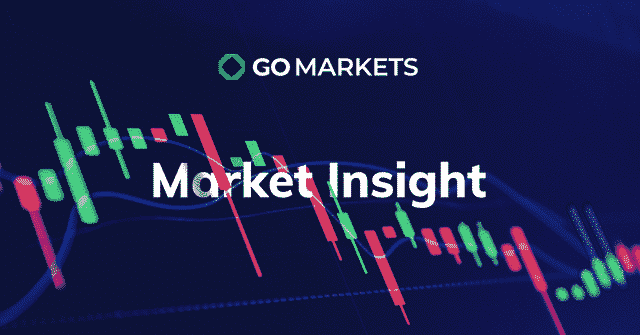

Gold has seen a resurgence in the past few weeks on the back of inflationary pressure and geopolitical tensions in Ukraine and Russia. Prior to the conflict, the price of Gold was hovering around $1,800 USD per ounce. After pushing through $2000 USD per ounce the price is now moving closer to its all-time high at $2070.
The rise in other commodities such as Oil, Gas, and Coal has also added to the rise in the price of Gold as concerns of inflation are increased, the interest in Gold usually follows. An interesting comparison can be made with regards to the increasing price of Oil. Whilst both commodities can be used as hedges against the market, Gold provides a more stable option whilst Oil is the more volatile option.
Both have seen strong rises due to the conflict and whilst Oil’s has been more meteoric, Gold has been steadier, as can be seen in the chart below. Gold has also performed extremely well against Bitcoin and other cryptocurrencies during the volatility that has been caused by the conflict. There was potential for Bitcoin and Cryptocurrency to provide a hedge against the market, however Bitcoin has been outperformed by Gold at this point.
Gold vs BTC vs Oil An interesting quandary to the Gold rise is the geopolitical element. For instance, Russia’s central bank purchased more Gold in 2021 than all other central banks, except for those in India and the United Arab Emirates. This means that there may be a shortfall in supply.
Technical Analysis The long-term chart has shown a long period of consolidation ultimately forming a symmetrical triangle pattern from which the price has broken out. It saw a big rise during the beginning of the pandemic and reached a maximum price of $2075 USD per ounce. When the price broke out of the triangle, initially an increase in relative volume occurred.
In addition, the retracement of the breakout was short-lived, and buying pushed the price up relatively easily. Another symmetrical triangle formed on the four-hour chart on the breakout of the breakout. Once again there was a strong increase in volume for the intimal move before it began the price began to contract again.
These continual price contractions and triangles forming may indicate that supply is being soaked up and that buying demand is present. On the four-hour time frame, it can be observed that the short sharp periods of consolidation have continued to be formed. Importantly, the consolidations have been relatively short, with in a tight range and broken with a high level of volume.
If volatility continues to be prominent and Inflation remains a threat, Gold will likely remain relevant. It will be interesting to see what happens with the price, if it is able to push through the all-time high price of $2075 per ounce.


For years, gold has been considered a store of value. As a physical commodity, it cannot be printed like money, and its value is not impacted by interest rate decisions made by a government. Because gold has historically maintained its value over time, it serves as a form of insurance against adverse economic events.
When an adverse event occurs that lingers for a while, investors tend to pile their funds into gold, which drives up its price due to increased demand. There have been many instances in our history, where war has ignited investment into gold. One particular moment in the 21 st century which signaled a strong movement into gold as a safe haven was the unfortunate event which occurred on 9/11.
Another was the Global Financial Crisis in 2008. In both instances gold’s price sored and it returned higher profits than any other financial asset. It’s important to understand at this stage, even though gold has these unique characteristics, it is not a long-term solution for a portfolio hedge or as a safe heaven.
Negative news tends to come after more negative news, which changes investor behaviors and tends to worry investors who in turn would sell their positions in gold, thus sending the price down to original levels or even lower. Some Key Points Safe haven investments offer protection from market downswings. Precious metals, currencies, and stocks from particular sectors have been identified as safe havens in the past.
Safe havens in one period of market volatility may react differently in another, so there is no consistent safe haven other than portfolio diversity. Latest Price Action Prior to Russia’s intentions of an invasion into Ukraine and fears of war, which is creating upheaval in the political landscape in Europe and around the world, gold was steadily rising in a sideways movement. However this past week you would have noticed a sharp price action jump 3% from $1892.00 to $1973.00 USD (see below), a price that we haven’t seen since 1 st of January 2021 and there is a strong feeling that it could push past this figure as Russia ramps up its invasion into eastern Ukraine.
If this happens, we could start to see higher highs as a result, as investors are spooked by the potential turmoil and destabilization. Gold or XAUUSD, can be accessible in different forms. You can purchase gold bullion in a number of ways: through an online dealer, or even a local dealer or collector.
A pawn shop may also sell gold. You are advised to note gold's spot price – the price per ounce right now in the market – as you're buying, so that you can make a fair deal. You could also find access to gold in the following ways: Gold Futures, ETFs that own gold, Mining Stocks, ETFs that own mining stocks, or you if you wish to trade it, you could use CFDs, where you can trade the value of the shiny metal when it goes up or down.
Visit our website here to get started with a CFD trading account and start taking advantage of opportunities. Sources: www.bankrate.com, Investopedia, Tradingview.


For the last 2 years, Gold has been bouncing in a range between $1700 and $2070 and is currently testing the major support level around $1700 as seen below. The price has used the yellow highlighted as an area for support zone and a rejection zone. Over the last 2 years clear rejections have occurred every time the price has reached around $1700’s.
These candlestick rejections indicate a high probability of something similar potentially happening. We find further confluence of this analysis by looking at the weekly time frame, where Gold has broken above the trend line, and has now come back to retest it. This can often result in a bounce off the trendline, creating the start of a new uptrend.
If Gold continues to remain above the trendline and can hold the monthly support, it may indicate that it is in the early stages of a potential reversal. This may lead to another move toward the $2000’s.


The first quarter of 2020 was marred by unpredicted events that rattled the financial markets: Tensions between US and Iran; The extreme weather conditions across the globe as a result of climate change; The novel coronavirus; and An oil price war between Saudi Arabia, the oil kingdom, and Russia. A Trio of Crises Faced by an unprecedented health crisis that caused an abrupt slowdown of activities, forced by governments and an oil crisis derived from a simultaneous demand and supply shock, the world is currently bracing for an economic recession. The markets tumbled like dominoes hit by various headwinds at once.
The freefall in the markets has forced central bankers and governments to implement various stimulus packages, emergency rate cuts and engage in significant bond-buying. Confidence has taken a massive hit as the world faces unprecedented quarantines measures! Volatility Index (VIX) A look at the CBOE Volatility Index shows how investors are reacting to the impact of the coronavirus on markets and the economy.
Also known as Wall Street’s fear gauge, the index is a real-time market index that represents the market expectation of 30-day forward-looking volatility. The Index, on average, has been around the 20 levels but increased to decades high at 82.69 on the 16 th of March 2020. The sharp rise is the reflection of fears and anxieties prevailing in the financial markets.
Source: Bloomberg Stock Market Busts and Circuit Breakers Circuit breakers were first introduced in the 1980s to curb panic selling. For the US exchanges, the S&P500 is used as the pricing reference to measure a market decline and there are currently three levels to the circuit breakers: Level 1 (7%) Trading will halt for 15 minutes if the drop occurs before 3:25 p.m. At or after 3:25 p.m.—trading shall continue unless there is a Level 3 halt.
Level 2 (13%) Trading will halt for 15 minutes if the drop occurs before 3:25 p.m. At or after 3:25 p.m.—trading shall continue unless there is a Level 3 halt. Level 3 (20%) At any time during the trading day—trading shall halt for the remainder of the trading day.
There were four circuit breakers in one month which is a record number ever since circuit breakers were first introduced! The novel coronavirus has created such uncertainty around the globe, which has caused plunges in global equities. Despite the VIX easing to 65.54, further wild swings seem certain in the next couple of weeks.
Source: Bloomberg Rescue Packages In such plunging markets, the focus has been on the rescue packages. Some world leaders were complacent at the beginning, however, we are now seeing highly coordinated intervention measures flooding the markets in an attempt to cushion the effect of the COVID-19 on the global economy. Central banks issued emergency rate cuts as well as other policy tools like quantitative easing (QE).
Major countries like Australia and New Zealand were forced to join the QE wagon to support their respective economies. Governments issued various massive stimulus packages to relieve consumers and businesses from the coronavirus fallout. The US stands out with a $2 trillion stimulus package, the biggest in history.
The rescue packages have not necessarily addressed the full extent of the economic pain which yet to be seen in the coming months, but have provided some relief to wounded economies. Stock Market – A Degree of Calm In the first quarter of 2020, it is evident that the 11-year bull run in the stock markets was over. Major equity indices dropped in bear market territory in what was the worst week since the global financial crisis.
Source: Bloomberg The stock market went on a roller coaster ride as investors pulled out of riskier assets. The degree of calm is driven by various interventions in the financial markets. But, the worst of the virus is not yet over and it may not yet be a lasting rebound.
It could well be a dead cat bounce. Notwithstanding, there are not enough signs to predict whether the stock market has found a floor or is yet to find a bottom. There are too many uncertainties to start pricing-in a recovery.
FX – The King Dollar? The currency market is on the same wild run as other markets. The immediate attention falls on the King dollar.
In the early stage of the outbreak, the US seemed relatively unfaed by the virus and the greenback gathered strength as a safe-haven compared to the rest of the world. As panic gripped markets, dollar funding pressures drove the US dollar index to a 3-year high above the 102 level. Source: Bloomberg Even though the greenback has somewhat retreated as policymakers stepped in to enhance flows, the US dollar index remains in elevated levels just below 100.
A significantly bigger stimulus package compared to its peers are fuelling hopes that the US economy would probably recover faster than other major economies. Gold – The Safe Haven The price movement of the precious metal also depicts the turmoil in the markets. At the start of the year, the US dollar and Gold were moving in tandem due to the prevailing uncertainties.
QE, low-interest rates, trade frictions, geopolitical tensions, global debt and growth uncertainties, gold hoarding by central banks have driven the gold price to a high of $1,680.47. Gold was liquidated due to the wider and rapid spread of the coronavirus across the globe. The precious metal is viewed as a highly liquid asset and investors were in a need of cash due to margin calls and other liquidity requirements.
The greenback and the US dollar have therefore started to diverge from each other. COVID-19-induced liquidity issues caused the yellow metal to plunge to a low of $1,471.24. Source: Bloomberg Once investors were reassured that central bankers are injecting money into the financial system, investors resumed the buying of gold as a safe-haven.
At the same time, gold is facing disruptions in the physical markets due to the shutdown of gold refineries leading to a shortage of gold. A combination of positive fundamentals, weaker US dollar and rescue packages lifted the XAUUSD pair back above the psychological level of $1,600. Source: Bloomberg The economic backdrop is creating a bullish environment for the precious metal.
Amid high volatility, Gold traders are likely going to keep monitoring any updates on the virus, liquidity in the financial markets, and the strength of the US dollar for fresh trading impetus. Volatility Means Opportunities Human lives and the global economy are at risk. The coronavirus has heavily impacted the way the world operates.
Even though the worst of the health crisis is not over yet, and many countries are bracing for another brutal quarter ahead, the health crisis will ease and end at some point. It is not all gloomy in the investment space despite the sharpest falls in history. The panic-driven volatility might present investment opportunities.
Investors will likely be in search of bargains by buying at rock-bottom prices once the number of coronavirus cases starts to slow down. An oil storage problem, higher storage costs, faltering demand and a significant rise in production are creating a perfect storm for the oil market.
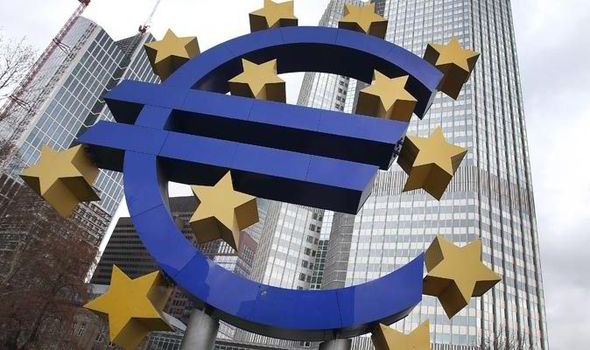

The Euro has fallen to 20-year lows as it deals with increasing energy prices and increased bond yields as recession fears rise again. Across both the UK and Europe inflation has been especially high even compared other countries such as Australia and the USA and in response, the EUR has taken a large hit. The recent spike in energy prices has brought back fears into the market that inflation has not yet peaked and will continue to rise.
Two potential opportunities are on the EURCAD and the EURUSD. Firstly, on the EURCAD the price is sitting just above its long term supports and its lowest levels since 2015. With seemingly no fundamental reason for the price to bounce in the short to medium term, it is possible the price sells through the 1.30 CAD level and falls further to the 1.21/1.20 level.
The 50-week moving average is almost in a free fall as the currency continues to sell. In addition, the RSI, whilst in oversold territory, is forming a descending triangle. This indicates that sellers may be gearing up again to begin another move down below the 30 RSI level.
Whilst the EUR continues to be smashed there is always the potential that the market will see value and see a rally in the pair. Therefore, it is important to have risk management tools in place such as a stop loss. A stop loss could be set above 1.32 which would represent a potential risk reward of almost 2.5:1.
The EURUSD is following is showing an even more aggressive sell off. The EUR has fallen to 20-year lows vs the USD. The worrying sign is that the price has faced very little resistance since it began diving in January 2022.
Every long-term support has been sold through with without much of a pullback. With the 1.00 USD level expected to be a tougher level to sell through, short opportunities still exist. The next level of support is around 0.95/0.96 USD which is the next logical target for a short entry.
However, once it reaches this level, it may prove very difficult to fall lower as it would me mean breaching 50 year low prices.


Dicker Data is an Australian-owned and operated, ASX-listed technology hardware, software and cloud distributor. They were founded in 1978. As a distributor, they sell exclusively to a valued partner base of over 5,500 resellers.
Dicker Data distributes a wide portfolio of products from the world’s leading technology vendors. Dicker Data have successfully navigated the end of governmental business stimulus and the impact of a global semiconductor chip shortage to post a net profit of $73.6 million, which is an increase of 29%. Sales figures increased 24% to $2.48 billion for the 2021 calendar year.
Dicker Data declared a final dividend of 15 cents (USD), 100% flanked, on total earnings of 42.6 cents per share. FY21 Results Highlights The company believes that shortages are a part of the computer business and have always planned around it. They identify the software sector to be its highest growth opportunity as dynamic workplaces, which allow employees to work from home, are currently in high demand.
They also identify that there will be a strong demand for audio-visual equipment, such as large format displays for meeting rooms, as workplaces welcome back employees to the offices. The company’s debt over the period has almost doubled to $230.2 million after they have announced debt funded deals to acquire its rival IT distributor, Exceed, for $68 million. They have also recently acquired Hills Ltd’s Security and Information Technology business for $20 million last month.
The company also has their sights on another acquisition in the future, they have been in talks with a few bankers to help finance a potential acquisition of a rival US-based IT distributor, Ingram Micro. Ingram Micro was sold to US private equity group Platinum Equity for $7.2 billion (USD) in July 2021. Prior to this, HNA Group acquired the business for around $6 billion (USD) in 2016.
Co-founder David Dicker stated that his company would have acquired Ingram Micro for $7 billion (USD) if they had been able to raise the capital. Dicker Data share value is slowly trending up since February’s acquisition. However, due to the Russia and Ukraine conflict, the ASX 200 index is currently dropping in value and this can trickle down to companies such as Dicker Data.
Overall, Dicker Data is currently in a growth state and is looking to acquire companies that would help increase the company’s value and offerings to its many clients. They aim to use debt to fund the acquisitions and then issue shares to pay down the debt once the acquisition is successful. The acquisitions have helped the company achieve a profitable year as evident in the earnings report.
With the acquisition target of Ingram Micro, this can be an exciting opportunity to track the progress from start to finish. If you would like to take this opportunity to invest in Dicker Data and don’t already have a trading account, you can register for a Shares account at GO Markets. Sources: ASX, TradingView, AFR.

